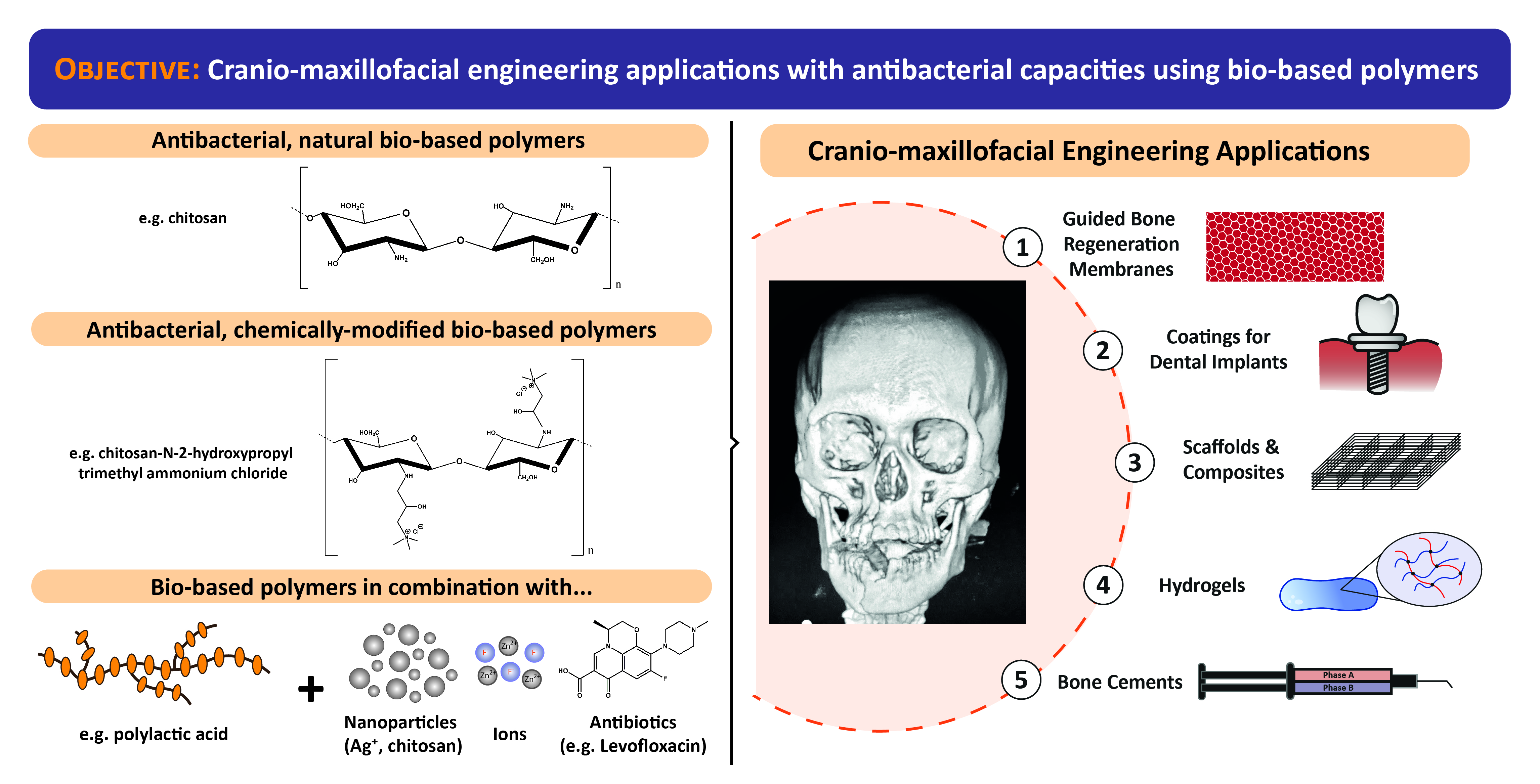Cranio-maxillofacial structure is a region of particular interest in the field of regenerative medicine due to both its anatomical complexity and the numerous abnormalities affecting this area. However, this anatomical complexity is what makes possible the coexistence of different microbial ecosystems in the oral cavity and the maxillofacial region, contributing to the increased risk of bacterial infections. In this regard, different materials have been used for their application in this field. These materials can be obtained from natural and renewable feedstocks, or by synthetic routes with desired mechanical properties, biocompatibility and antimicrobial activity. Hence, in this review, we have focused on bio-based polymers which, by their own nature, by chemical modifications of their structure, or by their combination with other elements, provide a useful antibacterial activity as well as the suitable conditions for cranio-maxillofacial tissue regeneration. This approach has not been reviewed previously, and we have specifically arranged the content of this article according to the resulting material and its corresponding application; we review guided bone regeneration membranes, bone cements and devices and scaffolds for both soft and hard maxillofacial tissue regeneration, including hybrid scaffolds, dental implants, hydrogels and composites.
3729048
{3729048:3YUM49IC}
nature
50
1
1
title
824
http://www.biomateriales.ictp.csic.es/wp-content/plugins/zotpress/
%7B%22status%22%3A%22success%22%2C%22updateneeded%22%3Afalse%2C%22instance%22%3A%22zotpress-86468f6c001747bcd1b14d71a06d764a%22%2C%22meta%22%3A%7B%22request_last%22%3A0%2C%22request_next%22%3A0%2C%22used_cache%22%3Atrue%7D%2C%22data%22%3A%5B%7B%22key%22%3A%223YUM49IC%22%2C%22library%22%3A%7B%22id%22%3A3729048%7D%2C%22meta%22%3A%7B%22creatorSummary%22%3A%22Mart%5Cu00edn-del-Campo%20et%20al.%22%2C%22parsedDate%22%3A%222020-01%22%2C%22numChildren%22%3A2%7D%2C%22bib%22%3A%22%3Cdiv%20class%3D%5C%22csl-bib-body%5C%22%20style%3D%5C%22line-height%3A%202%3B%20%5C%22%3E%5Cn%20%3Cdiv%20class%3D%5C%22csl-entry%5C%22%20style%3D%5C%22clear%3A%20left%3B%20%5C%22%3E%5Cn%20%3Cdiv%20class%3D%5C%22csl-left-margin%5C%22%20style%3D%5C%22float%3A%20left%3B%20padding-right%3A%200.5em%3B%20text-align%3A%20right%3B%20width%3A%201em%3B%5C%22%3E1.%3C%5C%2Fdiv%3E%3Cdiv%20class%3D%5C%22csl-right-inline%5C%22%20style%3D%5C%22margin%3A%200%20.4em%200%201.5em%3B%5C%22%3EMart%5Cu00edn-del-Campo%2C%20M.%2C%20Fern%5Cu00e1ndez-Villa%2C%20D.%2C%20Cabrera-Rueda%2C%20G.%20%26%20Rojo%2C%20L.%20%3Ca%20target%3D%27_blank%27%20href%3D%27https%3A%5C%2F%5C%2Fwww.mdpi.com%5C%2F2076-3417%5C%2F10%5C%2F23%5C%2F8371%27%3EAntibacterial%20Bio-Based%20Polymers%20for%20Cranio-Maxillofacial%20Regeneration%20Applications%3C%5C%2Fa%3E.%20%3Ci%3EApplied%20Sciences%3C%5C%2Fi%3E%20%3Cb%3E10%3C%5C%2Fb%3E%2C%208371%20%282020%29.%20%3Ca%20title%3D%27Cite%20in%20RIS%20Format%27%20class%3D%27zp-CiteRIS%27%20href%3D%27http%3A%5C%2F%5C%2Fwww.biomateriales.ictp.csic.es%5C%2Fwp-content%5C%2Fplugins%5C%2Fzotpress%5C%2Flib%5C%2Frequest%5C%2Frequest.cite.php%3Fapi_user_id%3D3729048%26amp%3Bitem_key%3D3YUM49IC%27%3ECite%3C%5C%2Fa%3E%20%3C%5C%2Fdiv%3E%5Cn%20%3C%5C%2Fdiv%3E%5Cn%3C%5C%2Fdiv%3E%22%2C%22data%22%3A%7B%22itemType%22%3A%22journalArticle%22%2C%22title%22%3A%22Antibacterial%20Bio-Based%20Polymers%20for%20Cranio-Maxillofacial%20Regeneration%20Applications%22%2C%22creators%22%3A%5B%7B%22creatorType%22%3A%22author%22%2C%22firstName%22%3A%22Marcela%22%2C%22lastName%22%3A%22Mart%5Cu00edn-del-Campo%22%7D%2C%7B%22creatorType%22%3A%22author%22%2C%22firstName%22%3A%22Daniel%22%2C%22lastName%22%3A%22Fern%5Cu00e1ndez-Villa%22%7D%2C%7B%22creatorType%22%3A%22author%22%2C%22firstName%22%3A%22Gabriela%22%2C%22lastName%22%3A%22Cabrera-Rueda%22%7D%2C%7B%22creatorType%22%3A%22author%22%2C%22firstName%22%3A%22Luis%22%2C%22lastName%22%3A%22Rojo%22%7D%5D%2C%22abstractNote%22%3A%22Cranio-maxillofacial%20structure%20is%20a%20region%20of%20particular%20interest%20in%20the%20field%20of%20regenerative%20medicine%20due%20to%20both%20its%20anatomical%20complexity%20and%20the%20numerous%20abnormalities%20affecting%20this%20area.%20However%2C%20this%20anatomical%20complexity%20is%20what%20makes%20possible%20the%20coexistence%20of%20different%20microbial%20ecosystems%20in%20the%20oral%20cavity%20and%20the%20maxillofacial%20region%2C%20contributing%20to%20the%20increased%20risk%20of%20bacterial%20infections.%20In%20this%20regard%2C%20different%20materials%20have%20been%20used%20for%20their%20application%20in%20this%20field.%20These%20materials%20can%20be%20obtained%20from%20natural%20and%20renewable%20feedstocks%2C%20or%20by%20synthetic%20routes%20with%20desired%20mechanical%20properties%2C%20biocompatibility%20and%20antimicrobial%20activity.%20Hence%2C%20in%20this%20review%2C%20we%20have%20focused%20on%20bio-based%20polymers%20which%2C%20by%20their%20own%20nature%2C%20by%20chemical%20modifications%20of%20their%20structure%2C%20or%20by%20their%20combination%20with%20other%20elements%2C%20provide%20a%20useful%20antibacterial%20activity%20as%20well%20as%20the%20suitable%20conditions%20for%20cranio-maxillofacial%20tissue%20regeneration.%20This%20approach%20has%20not%20been%20reviewed%20previously%2C%20and%20we%20have%20specifically%20arranged%20the%20content%20of%20this%20article%20according%20to%20the%20resulting%20material%20and%20its%20corresponding%20application%3B%20we%20review%20guided%20bone%20regeneration%20membranes%2C%20bone%20cements%20and%20devices%20and%20scaffolds%20for%20both%20soft%20and%20hard%20maxillofacial%20tissue%20regeneration%2C%20including%20hybrid%20scaffolds%2C%20dental%20implants%2C%20hydrogels%20and%20composites.%22%2C%22date%22%3A%222020%5C%2F1%22%2C%22language%22%3A%22en%22%2C%22DOI%22%3A%2210.3390%5C%2Fapp10238371%22%2C%22ISSN%22%3A%22%22%2C%22url%22%3A%22https%3A%5C%2F%5C%2Fwww.mdpi.com%5C%2F2076-3417%5C%2F10%5C%2F23%5C%2F8371%22%2C%22collections%22%3A%5B%5D%2C%22dateModified%22%3A%222021-01-15T07%3A58%3A47Z%22%7D%7D%5D%7D


